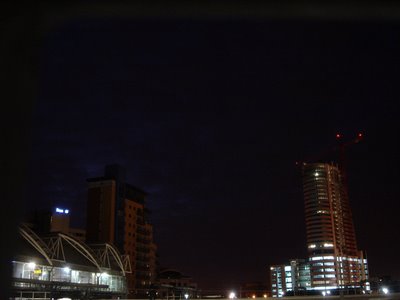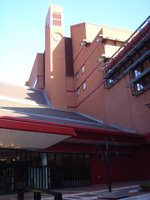Originally I wanted to travel the evening before, to spend a night in London. But I had lots of things to do here in Leeds, so I could not afford this. Instead, I got up early, drove to Leeds train station, and took a morning train to London. The ride takes 2h 10 minutes, from Leeds to Londong Kings Cross. I was quite tired, so I slept most of the time.
 Early morning at Leeds Train Station.
Early morning at Leeds Train Station.The conference venue was the British Library, just a few steps from the train station Kings Cross.
This one-day conference served two purposes:
- for the senior management of EPSRC to give an overview on the future funding strategy
- f or the participants to network for possible collaboration opportunities.
The first presentation was given by Professor Dame Julia Higgins, chairman (chairwoman?) of EPSRC since 2003 (vacating the post in 2007). She pointed out the results of an earlier consultation process, which identified the following research themes:
- Creativity and adventure.
- Supporting of talented people
- Building collaborations.
- Crossing borders.
- Shared vision with stakeholders (e.g. industry).
- Better understanding.
- World-leading researchers in the UK.
She presented five strategies for success:
- Partner relationship management, where EPSRC would partner with enterprises or institutions (e.g., an existing partnership with Philips).
- Empowering and incentivising, leading to long-term commitments for long-term research projects.
- Research careers: funding CASE studentships and advanced fellowships.
- Grand Challenges: organising "sandpits" with about 25 researchers for 5 days. Special topics: "computing with uncertain future devices", and "emergence".
- International engagement.
The 2nd speaker was Professor John O’Reilly, Chief Executive of EPSRC. He pointed out the vision of EPSRC: "to make UK the most dynamic and stimulating environment in which to engage research and innovation". In order to achieve this goal, he noted that the following pillars are necessary: excellence (ensured by peer review), engagement (with strategic advisory teams), and empowerment (by giving platform grants and fostering portfolio partnerships. Researchers are encouraged to submit unsolicited proposals. He identified the following areas: health, crime&terrorism, e-science, energy, nano-science, and digital economy.
For both Julia Higgins and John O’Reilly, this was their last performance in their official duties – as their posts will both vacate in 2007. Prof. Randal Richards will be the interim Chief Executive until an official successor has been determined.
The 3rd speaker was Professor Sir Michael Brady, U. Oxford. In his presentation he talked about technical progress in image fusion and about symbiotic relationship between academia and industry.
The last speaker was Dr. Malcolm Roberts, Managing Director of Guidance Ltd, who made the case for close collaboration between industry and academia, representing the business side. His company pays an annual license fee of 1 M £ to University of Oxford for a specific tracking technology (laser guidance and navigation) which had been developed there.
 The morning concluded with a Q&A session where the participants could post their questions to the panellists. These questions led to discussions over the benefit of a longer funding period and to the RAE 2008 and the future implementation of RAEs with a move to metrics.
The morning concluded with a Q&A session where the participants could post their questions to the panellists. These questions led to discussions over the benefit of a longer funding period and to the RAE 2008 and the future implementation of RAEs with a move to metrics.I could then have gone back with the next train to Leeds, but I wanted to use the time here in London for a bit of sightseeing. First of all, I went to an exhibition right here in the British Library. There were manuscripts from the past millenium, some dating back to the 11th century. The Magna Carta is there, manuscripts of composers, writers, scientist. Fascinating.
Then I decided to walk for the remaining hour with daylight through the city centre, down to the Thames, then back up with the subway to the train station. No rain this time, a very pleasant crisp autumn weather. I got stuck in the area with all the electronic stores... lots of gadgets there to buy!
 As the sun set, I walked over the pedestrian bridge near the "London Eye", tbe big wheel. From Waterloo Station, I then took a subway back to Kings Cross.
As the sun set, I walked over the pedestrian bridge near the "London Eye", tbe big wheel. From Waterloo Station, I then took a subway back to Kings Cross.
As I came back to the station, there was already a long line queuing for the 17:03 train. Just 10 minutes before departure, the line was allowed to move forward to the platform and enter the train. I was not able to get a seat, and so I stood together with others in the exit area of the car. Only after the first stop, after one hour in Peterborough, most people left the train, and seats were vacant. I came back home around 20:00.
No comments:
Post a Comment